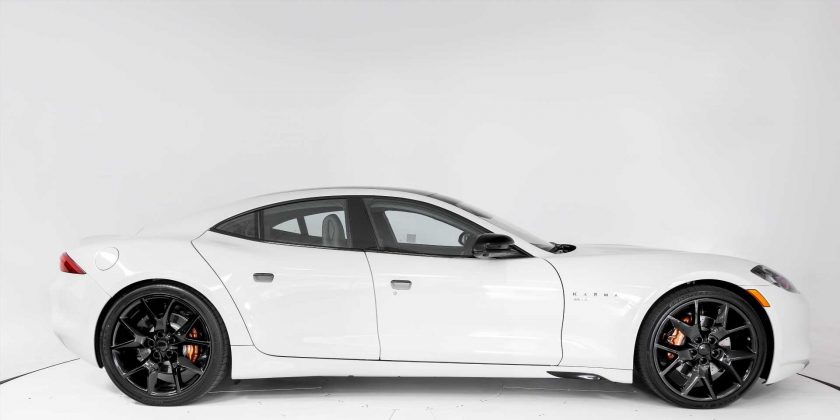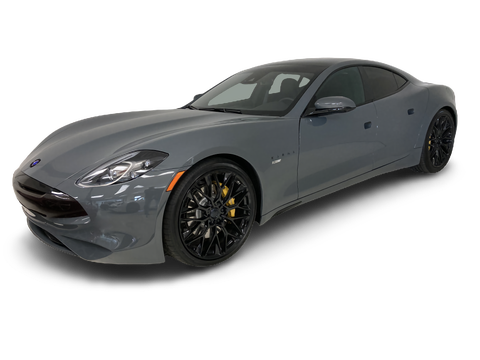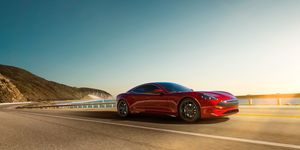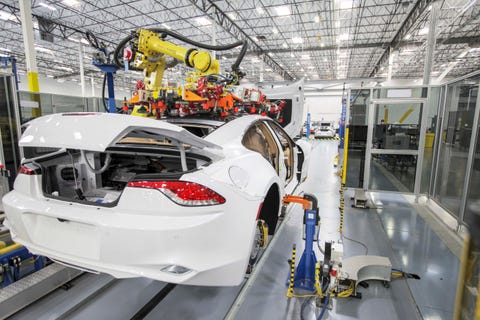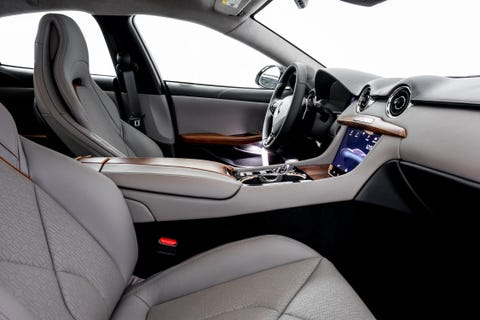Whatever happened to Karma Automotive, anyway? This is a question that pops up every couple of years, and conveniently, in a Zoom-meeting press scrum last week we got an update.
Karma is introducing a “new” model called the GS-6, a plug-in hybrid which may look like a Revero GT but which is, again, “new.” Like Revero, it is powered by a series hybrid with a version of the BMW three-cylinder gasoline engine that powers the i8. That gasoline engine spins a generator to produce electricity for the car’s 28-kWh lithium-ion battery pack. Being a PHEV, GS-6 owners can also plug in to household current or to a 240-volt 32A Level 2 charger, or even take 480 volts of DC charging at 125A to juice up the battery. In fact, 72 percent of all the miles driven on the nearly 1000 Karmas sold since 2014 have been driven solely on electricity. (Karma calls the car an extended-range electric vehicle, or EREV. Maybe that sounds more appealing than saying it’s a plug-in hybrid.)
Outside, the GS-6 looks very much like the current Revero and Revero GT, though Karma asserts somewhat vaguely that there are changes “under the skin,” without really saying what those changes are.
So did Karma just realize that $154,600 was too high a price to ask for a design we first saw back in 2008?
“Our brand promise at Karma has always been to provide high-end luxury vehicles and technologies that are driven by innovation and inspire our drivers’ ambitions with new and unique offerings,” said Lance Zhou, Karma’s CEO. “As we look to the future, we believe we can change the world of mobility by making luxury electric vehicles more accessible.”
The big difference is price. The GS-6 comes with a window sticker of $83,900, almost half that of a fully loaded Revero GT. The pricing will certainly open the Karma up to a much wider range of buyers.
“When we were founded in 2014, the mission from our owners was, built me a brand that is living between super luxury, where they start, and premium, where it ends. And we build that whitespace for us quite successfully in that very small niche of markets where we were and people love the car,” said Joost de Vries, vice president of global sales and customer experience. “There’s just not enough people in that segment to actually sell cars to.”
The price reduction will be a big step for the post-startup carmaker.
“So, who did we used to sell to?” de Vries asked rhetorically. “Mid- to late career, we were a congratulatory purchase. The FICO scores were 800-plus or none at all. We were car number four or car number five in the garage. Our number one trade-in was a Quattroporte, our number-two was a Porsche Panamera, our number-three was the Tesla Model S, and then BMW i8. We were truly a congratulatory purchase, very successful where we needed to sell but a very, very small market segment.”
So what’s it going to be like at half price?
“By moving our price significantly down, we’re touching a very different demographic,” de Vries said. “We’re now looking at people in their mid-40s. They still have children, their household incomes are $150,000, we become an aspirational brand. We’re suddenly seeing trade-ins like an F-150 or a Jeep Wrangler. It’s a completely different world for us and it’s super exciting because the brand is strong enough to carry that customer profile. Our pricing just needed to match what that customer profile is interested in. And that’s what we’re looking for with the launch of this new product.”
The PHEV GS-6 makes 536 hp and 550 lb-ft of torque, Karma says. It is powered by two electric motors at the rear wheels going through a single-ratio direct-drive gearbox with an electronic limited-slip diff. Suspension at all four corners is independent SLA, or short-long-arm setup. Brakes are discs all around with six-piston calipers in front and four rear.
Since so many buyers make their choices based on whether their phones can do anything in the car, the GS-6 will have both Apple CarPlay and Android Auto with Bluetooth wireless audio streaming and hands-free calling. Audio comes through eight speakers at 680 watts. It’s also loaded with all the acronyms like blind spot monitoring (BSM), rear cross traffic alert (RCTA), adaptive cruise control (ACC), and a host of others.
It’s not the only new product coming from Karma. In addition to the GS-6 plug-in hybrid, Karma will launch a pure battery-electric by the end of this year called the GSe-6. Pricing on that model will be even lower, at $79,900 (not clear is if those prices include destination charges, which range from $1,400 to $1,800 on current Karmas). The GSe-6 will have up to 300 miles range from a battery pack as large as 105-kWh. Performance and driving of the GSe-6 pure EV feel should rival the GS-6.
“When we take out the generator (the three-cylinder gasoline-powered internal combustion engine and its ancillary parts), the weight difference between the full electric pack with the 85-kWh pack is a little less weight than the current (car) with the 105-kWh pack. It will be about 40 pounds higher in weight but the weight distribution is about the same. So I’m not worried about the performance envelope. I think you’ll see if not the same, very, very similar zero-to-60. So four and a half seconds and 3.9 seconds (depending on trim levels),” said de Vries.
Karma even announced a partnership to make a fuel cell vehicle. A Danish company called Blue World Technology will integrate one of its fuel cells with Karma Automotive’s electric vehicle architecture and the design will be piloted in GS-6 development vehicles for “evaluation purposes,” Karma said a couple weeks ago. The unit does not require pure hydrogen to operate, like all fuel cell vehicles on the road today. Rather, it will produce its own hydrogen from methanol in an on-board reformation process not seen in production fuel cell vehicles since the early days of fuel cell experimentation over 25 years ago.
“Methanol is a hydrogen-carrier commodity fuel already traded world-wide and it can be stored and distributed using the existing infrastructure in many countries around the world,” Karma said in a statement two weeks ago. “As a green alternative to fossil fuels, methanol can be produced using renewable sources, ensuring a CO2 neutral proposition.”
So PHEV, EV, and FCEV. What’s next? With so many powertrain programs underway, you have to wonder how Karma’s funding all this. Officially, it is still supported by Wanxiang, the Chinese Tier 1 supplier that bought Karma and battery supplier A123 Systems in 2014 when Fisker went bankrupt. But in July of last year Karma raised $100 million from outside investors and was aiming to raise more, so maybe everything will be alright.
The only question that remains—at least to some—is how much longer the basic Karma design, which we first saw in 2008 under the previous owner/founder Henrik Fisker, will remain fresh? With fewer than 1,000 Karmas in the wild, chances are you still won’t see another one on your daily drive.
For today the news is the lower-price on the GS-6 PHEV, which will almost certainly spur sales significantly.
“We’re proud that we have been designing, engineering, producing, selling, and servicing luxury EV vehicles for years now, which is something other EV startups can’t say,” said de Vries. “The GS-6 with its more attainable price point, combined with a long list of standard convenience features and luxurious design, the GS-6 will appeal to a much larger audience.”
Sign up to leave comments and let us know what you think of the new/old Karma GS-6.
Source: Read Full Article
